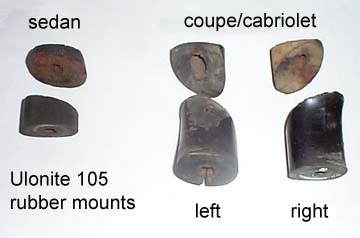Mercedes-Benz Ponton
ULONITE Reflectors
ULO No. 105 / No. 135 / No. K1320
View Supplement 1
Ponton Coupé and Cabriolet ULONITE Reflectors
ULONITE No. 105
In the USA after mid-1959 all Mercedes-Benz Pontons (and both the 190SL [W121 II] and the 300SL [W198 II] roadsters) were required to have small red reflectors mounted inboard of each tail light and above the rear bumper.
These are known as ULONITE 105 reflectors (000-544-14-05). ULONITE is still a major supplier to Daimler AG, but they
are alleged to have lost the tools to make the No. 105.
September 2014: New ULONITE No. 105 reflectors, and the rubber mounts are
available (see
Authentic
Classics link). Given today's high value of the rare, New Old Stock
(NOS), used, or even reconditioned ULONITE No. 105 reflectors, it seems like
a strong business case for ULONITE to tool-up, and make a batch run
(including the rubber mounts) for distribution to the Mercedes-Benz Classic
Centers, and after-market vendors around the world. Perhaps the economies of
scale are not there – who knows?—Ed.
In Europe, both the 190SL roadster (W121 II – 5/55 - 2/63) and the 300SL roadster (W198 II – 8/57 - 2/63) used the ULONITE No. K1320 reflectors, which were slightly larger than the ULONITE 105. Note the ULONITE 135 (still available today) is a direct replacement for the ULO K1320.
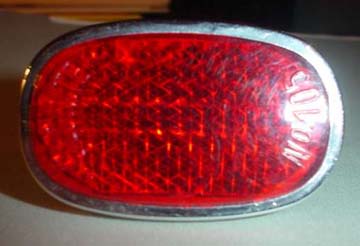
This is a rare NOS ULONITE 105 reflector.
Original Mercedes-Benz part number 000-544-14-05. They were mounted vertically on the four and six cylinder Ponton sedans, coupés
and cabriolets, and and horizontally on the Type 190SL and 300SL roadsters.
They were also used on certain post-Ponton Mercedes-Benz models such as
the W110 (a.k.a. "Heckflosse" or "Fintail") Universal wagons.
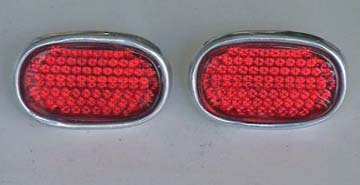
ULONITE No. 105 reflectors
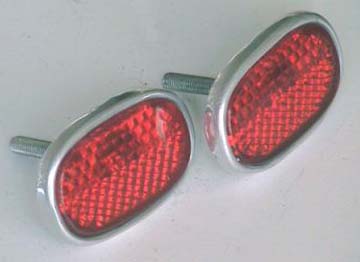
Threaded studs at the back of the
ULONITE 105 reflectors

1959 Mercedes-Benz Type 219 Ponton sedan with ULONITE No. 105 reflectors mounted vertically and
inboard of the tail lights. The bumper guards also feature the slightly larger
ULONITE No. K1320 reflectors. Photo:
Robert Hall /
Placerville, California / February 16, 2012
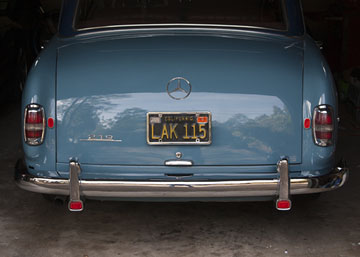
Robert was "on-the-lookout" for NOS ULONITEs for almost 20 years!
Photo: Robert Hall
/ Placerville, California / December 22, 2013
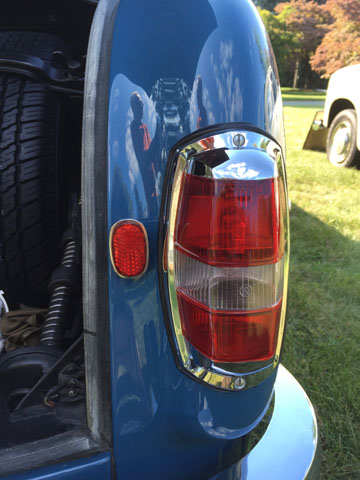
ULONITE 105 reflector on Mardy von Harten's 1958 Type 180D.
Photos taken at IPOG ECPC III / Malvern, PA /
September 18, 2015 / Courtesy: Jeff
Miller
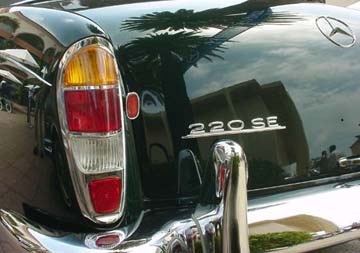
Mercedes-Benz 220SE cabriolet with the ULONITE 105
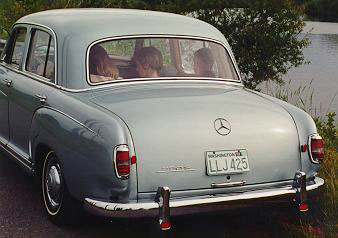
1959 Mercedes-Benz Type 220S Ponton sedan with ULONITE No. 105 reflectors mounted vertically and
inboard of the tail lights. The bumper guards also feature the slightly larger ULONITE No. K1320 reflectors. Photo: Ray Ilich
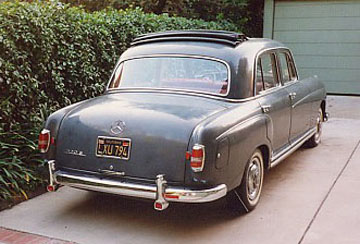
1959 Mercedes-Benz 220S sedan with Webasto sliding sunroof and ULONITE 105
reflectors.
The bumper guards use the slightly larger ULONITE No. K1320 (or No.135) reflectors.
Photo: Dick Hartt / Pasadena, California
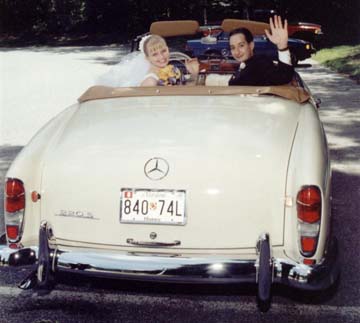
1959 Mercedes-Benz 220S cabriolet with ULONITE 105 reflectors
Photo: Len Sokoloff
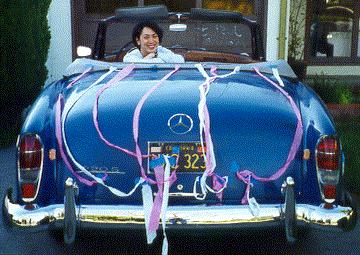
1958 220S cabriolet with the ULONITE 105 reflectors
Photo: Ron van Seventer

USA spec. Type 190SL roadster with ULONITE 105 reflectors
Photo: Peter Snihur / Hopewell Junction, NY
In the USA, the 190SL had reflectors mounted under the bumper until
sometime in 1958 when the United States Department of Transportation (USDOT)
got involved, and wanted them higher, thus the reflectors were moved to the
tail panel – for USA cars only. The correct mounting on the Type 190SL is horizontal, while
the Ponton sedan, coupés and cabriolets were mounted vertically. The 300SL roadster (W198 II — 8/57 - 2/63)
also had ULONITE 105 reflectors mounted horizontally, but had a unique mount.
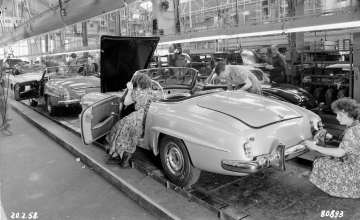
Assembly line showing horizontal orientation of ULONITE 105 reflectors
– destined for the USA market.
Click to view the full image, including a 190SL with the larger ULONITE
135 reflectors mounted beneath the bumper, which was destined for a market other than the USA.
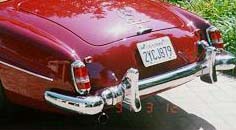
This 190SL has the ULONITE 105 reflectors mounted horizontally (correct)
inboard of the tail lights.
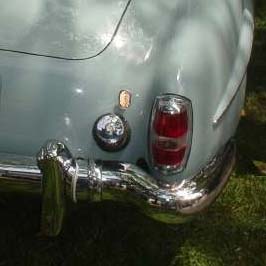
A sun-faded ULONITE 105 on a 190SL mounted vertically (incorrect).
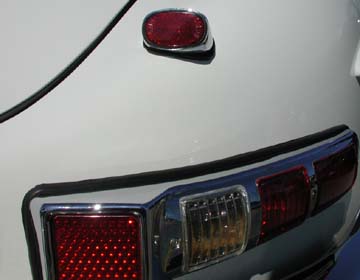
1962 Type 300SL (W198 II) roadster (8/57 - 2/63) with the ULONITE 105.
Photo: Jeff Miller / June 2, 2002
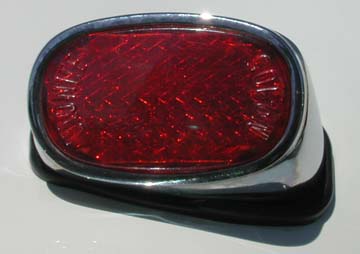
Detail of the right side ULONITE No. 105 on the 1962 300SL (W198 II) roadster.
Photo: Jeff Miller / June 2, 2002
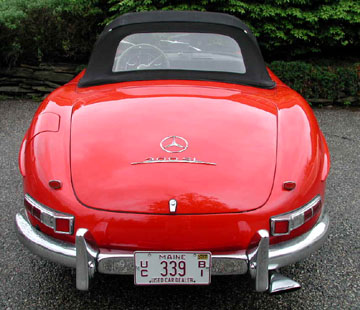
Type 300SL (W198 II) roadster (8/57 - 2/63) with the ULONITE 105.
Granite State (New Hampshire) Mercedes-Benz gathering / Photo: Jeff Miller
/ June 17, 2002
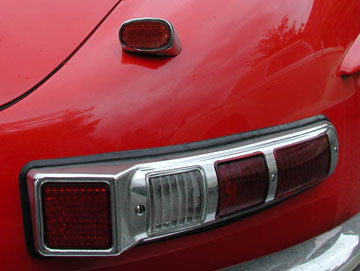
Detail of the right side ULONITE No. 105 on the 1962 300SL (W198 II) roadster.
Granite State Mercedes-Benz gathering / Photo: Jeff Miller / June 17, 2002
ULONITE No. K1320 (European Specification)
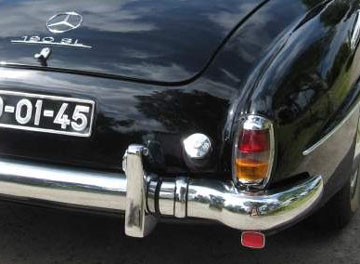
Amber blinker lenses identify this example as a European spec. (France) Type 190SL roadster
with ULONITE K1320 reflectors mounted under the bumper.
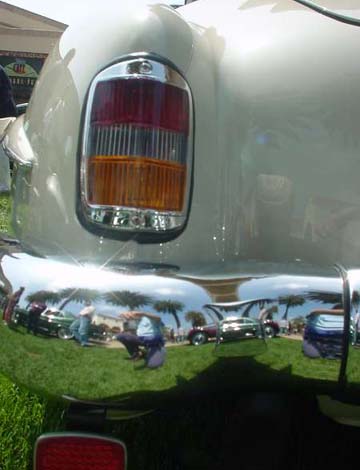
European specification Type 190SL with ULONITE K1320 reflector
under the bumper.
Photo: Ron van Seventer
This early European specification (note amber turn signal lens) Type 190SL has
ULONITE K1320 reflectors mounted below the bumper. Note the ULONITE 135 is a direct replacement
for the ULO K1320. Later 190SL roadsters (in the USA market) had the ULONITE 105 reflectors mounted
inboard (and horizontally) from the tail lamps. Note the ULONITE reflectors were originally
made of glass and later changed to plastic.

ULONITE K1320 reflector on Type 190SL (note amber blinker
lens)
Photo: Ricardo Alarcón Jiménez
The European spec. 190SL roadsters have ULONITE K1320 reflectors
mounted under the bumper as shown here. The K1320 reflectors are different than the USA spec. cars, and also different
than the Ponton sedans, coupés, and cabriolets.

ULONITE K1320 reflector on Type 300c "Adenauer"
Photo: Ricardo Alarcón Jiménez
The under-bumper reflector position was shared with the 300SL "Gullwing" and the 300 "Adenauer." These are photos of my 190SL and 300c
Adenauer – Ricardo Alarcón Jiménez / June 22, 2013
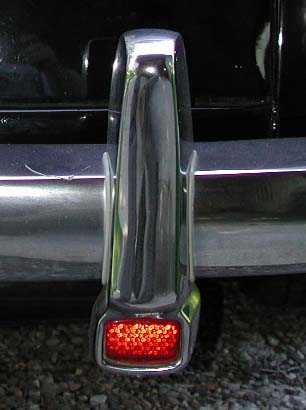
This is the right rear bumper guard of a 1957 Mercedes-Benz
Type 190 sedan (European specification). The original ULONITE reflector in the lower portion of the
rear bumper guard was stamped "ULO K1320." A direct replacement for the K1320
is the ULONITE No. 135. The original Daimler-Benz (DB) part number for this reflector was 10 120 826 01 40. Photo: Jeff Miller
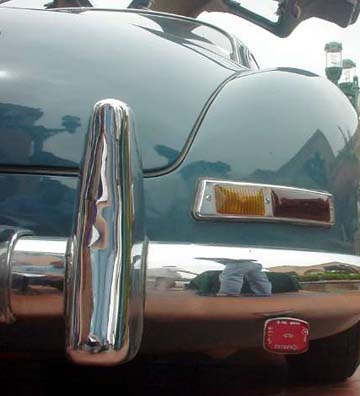
Type 300SL (W198 I) "Gullwing" coupé (8/54 - 5/57)
ULONITE K1320 (a.k.a. ULONITE No. 135) – European spec. with amber blinker lens
Photo: Ron van Seventer
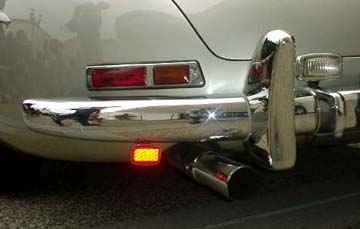
Type 300SL (W198 I) "Gullwing" coupé (8/54 - 5/57)
ULONITE 135 – USA spec. with red blinker lens
Photo: Ron van Seventer
ULONITE No. 135
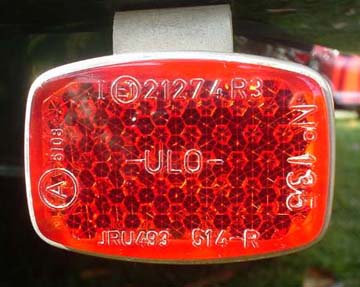
This is an ULONITE No. 135 mounted to a Porsche 356. The ULONITE
135 was also used on the Mercedes-Benz 300SL "Gullwing" coupé. They were mounted
below the bumper in both applications. There are other Mercedes-Benz Ponton
models that use the ULONITE No. 135 as well. Photo: Ron van Seventer
Possible Sources for ULONITE No. 105 Reflectors
When this page was created in 2002, the ULONITE No. 105 reflectors
were no longer produced, and difficult
to find in any condition.
The slightly larger ULONITE No. 135 reflectors are
readily available (6/2002). The ULONITE No. 135 is used for different
applications than the ULONITE 105, and are not interchangeable.
-
NLA Limited / Stocks the ULONITE 135 (for M-B 300SL and Porsche 356).
- Check other vendors on the Links page for
availability.
|
NLA Limited
Restoration Parts For Vintage Porsche Cars / Nevada
www.nlaparts.com
Check the dimensions of your Mercedes-Benz Ponton
ULONITE reflectors before contacting NLA Limited to be sure they will fit your car. The Mercedes-Benz
300SL "Gullwing", and Porsche 356 roadster both use the ULONITE No. 135.
The four and six cylinder Mercedes-Benz Ponton sedans have rear bumper guards
which also use the ULONITE No. 135 (up to about the middle of 1959).
Certain Mercedes-Benz Type 190SL roadsters also use the ULONITE No. 135.
See examples elsewhere on this page.
Parts diagram for the ULONITE No. 135 (larger than the ULONITE No. 105).
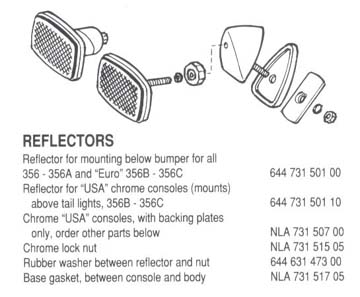
Diagram courtesy NLA Limited
|
Supplement 1
Mercedes-Benz Ponton Coupé and Cabriolet ULONITE Reflectors
Edited excerpt from the International Ponton Owners Group (IPOG) forum.
Contributors: Doug Broome / Jack Kotrba
November 7, 2006
Doug writes,
"I removed and examined the ULONITE 105 reflectors
on my 1959 Mercedes-Benz Type 219 sedan and 1959 Type 220S
cabriolet and observed the following:
The reflectors themselves, including the threaded stud, are the same all around.
The stud was slightly, but differently, angled on a couple of them, but after
examination I concluded that this was the result of trauma and not an original feature.
According to Werner Karasch in Germany, the original Mercedes-Benz part
number for the ULONITE 105 reflectors was 000-544-14-05.
The spacers are different front and rear, and left and right, on the cabriolet.
For example, the left outside spacer goes only in that location.
On the sedan, both outside spacers appear to be identical; one
simply installs them reversed left versus right. Ditto the spacers
inside the wheel well. I am not 100% certain about this, but it
looked that way. I neglected to try to install them opposite the
left or right side from which I removed them. If they are not
identical left versus right, they are very close.
The rear spacers on the sedan were more or less mirror images
of the front spacers. They had a hole which the stud exited to
receive a washer and nut. The inside spacers on the cabrio had a
threaded tube molded into them. From inside the trunk one fits a
screw into the threaded tube and somehow that turns onto the
ULONITE's stud. Rather a peculiar arrangement, but I conclude
that it was necessary because Uloniote 105s all came with the same
length stud and the cabrio's distance for mounting it was rather
longer than the sedan's.
All spacers originally had Mercedes-Benz part numbers marked on them.
On all mine, however, they were so worn as to be unreadable. I did
see enough on the cabrio's spacers probably to confirm the numbers
that Jack Kotrba provided.
There is no way, repeat no way, the cabrio ULONITE spacers would have
fit on a 190SL. The coupé/cabriolet mounting angles are way too sharp.
As I have not examined a 190SL yet, however, I cannot comment as to
whether the sedan spacers also fit them. I shall have to
determine this another time.
Exactly when the ULONITE 105 began to be fitted to USA-specification
Mercedes-Benz Ponton
sedans, coupés, and cabriolets is still a subject of conjecture. I did
read, however, in the September 1992 issue of the Mercedes Collector
(No. 4), F. Mallory, ed. where Ron Rapp wrote at p. 26 that the
reflectors were moved from under the bumper to the body in December
1957 on the Type 190SL with USA specifications. One may reasonably infer,
therefore, that the reflectors went on USA-specification Ponton
sedans, coupés, and cabrios at the same time. Still, I have not
found anything conclusive or determinative."
Jack Kotrba contributed the following narrative and photos.
I do not know if the black mounting tube came as an integral feature of the ULONITE 105 or whether it was supplied separately
from the reflector itself. I can say from observation that the
tubes differ on sedans versus coupés/cabrios. In addition, the mounting angle
(the cut along the mounting end) of the black tube differed on the sedan versus
coupé/cabrio. Finally, the coupé/cabrio mounting tube is much longer than on the sedan and is not split into
two sections.
This photo shows the part number on the piece
The sedan mount on the left and the coupé/cabriolet mount on
the right
|
ULONITE rubber mounts for Mercedes-Benz Ponton coupés and
cabriolets. |
| Location |
Mercedes-Benz Part Number |
| Left Inner |
180 987 03 37 |
| Left Outer |
180 987 01 37 |
| Right Inner |
180 987 04 37 KZ |
| Right Outer |
180 987 02 37 KZ |
There were no letters after the left side numbers. I think all the sedans use the same pieces. These pieces go on either
side of the body sheet metal with the stud from the ULONITE going through both to fasten it on.
|
|
Removing ULONITE 105 Reflectors |
If your reflectors are in the original position
(just inboard of the taillights where the fender meets the trunk lid), you
will find the mounting stud accessible from inside the fender, not the trunk.
There are two angled rubber pieces – one behind the ULONITE and one inside
the fender. Make sure you use penetrant before unbolting, as it is easy
to snap the bolt if the nut is seized.
Dan Diamond / Toronto / June 20, 2005
|
Created: May 21, 2002 / Jeff Miller
Revision H / May 16, 2021
© www.mbzponton.org
Thanks to: Dan Diamond, Ron Rapp, Len Sokoloff, Ron van Seventer
Return to the Mercedes Ponton FAQ page
Return to the Mercedes Ponton page





























